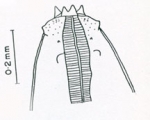NEIHPID
North-East India Helminth Parasite Information Database
Recently added
Parasites
Molecular Data
Setaria bernardi (Railliet et Henry Railliet et Henry)
Taxonomy
Nematoda »
SECERNENTEA »
Onchocercidae (Leiper, 1911) Anderson et Bain, 1976 »
Setariinae Yorke et Maplestone, 1926 »
Setaria Viborg, 1795 »
Setaria bernardi, Railliet et Henry 1911
Synonyms
(Setaria congolensis Railliet et Henry, 1911; Artionema bernadi (Railliet et Henry, 1911) Yeh, 1959)
Host
Sus (scrofa domestica)
Habitat
Peritoneal cavity
Locality
Shillong (Meghalaya), Nongstoin (Meghalaya)
Description
General
General appearance of worms like that of S. cervi. Peribuccal chitinous crown oblong, slightly elongated dorso-ventrally; four crown pointed, directed outwardly in dorsal and ventral views; denticles distinctly separate, appearing bifurcate in median view. Four pairs of sub-median papillae lying just below head end, arranged in two levels; pair of lateral amphids lying at nearly same level. Oesophagus differentiated into short anterior, long posterior portions.
Male
Body 95 mm in length, 0.63 mm in maximum width. Posterior extremity weakly spiraled. Pair of tiny lateral appendages present very near to tail tip. Tail bearing four pairs each of pre- and post-anal, papillae, one central papilla in front of cloaca, pair of small papillae near its end; of pre-anal papillae first two pairs arranged symmetrically, third asymmetrically, last pair symmetrically very near to cloaca; post-anal arranged quite asymmetrically, except last pair symmetrically close to tail end. Spicules markedly unequal; left spicule long, consisting of tubular proximal, distal membranous portions; right spicule small, stout.
Female
Body 105.0-120.0 mm in length, 0.82-0.99 mm in maximum width. Tail coiled spirally, having many short spines, in some specimens terminating in bulbous dilation. Caudal appendages small, rounded very close to tip.Vulva opening in oesophageal region; sphincter stretching little distance behind. Vagina fusiform, highly muscular; ovejectors divided into two uteri. Eggs oval, thin shelled, containing coiled microfilaria.
Remarks
Bernard and Bauche (1911) recovered a filariid in the abdominal cavity of domestic pigs of Vietnam and described it as Filaria sp. Ralliet and Henry (1911) also described a species Setaria congolensis from wild pigs in Africa . and stated that the parasites discovered by Bernard and Bauche though belonged to the genus Setaria, represent a distinct species, for which these workers proposed the name Setaria bernardi. However, the non-availability of the original description led same workers to doubt the validity of the species. Sandground (1933), after studying Setaria from Indo-China, concluded that S. bernardi should be treated as a synonym of S. congolensis. However, Yeh (1959) and Desset (1966), after studying the type specimens of the two species, reached to a conclusion that they are two independent and valid species.
In possessing an oblong peri-buccal crown and in general features of the posterior end of the body, the specimens under the present study are identified as S. bernardi and differ from other species of Setaria reported from Suidae, viz., S. thomasi, S. congolensis and S. castroi. The morphometric measurements of the present specimens tally closely with those described by Shoho and Machida (1979) from Japan except for minor variations in the length of the body, i.e., male 95.0 and female 105.0-220.0 mm as compared to 66.0- 78.0 and 88.0-165.0 mm, respectively by the latter authors.
The genus Setaria is found to be of relatively less common occurrence in the members of the Suidae (Yamaguti, 1961). So far only four species of the genus are known from these hosts elsewhere in the world. Though several species occur in Indian ungulates, there are apparently few reports of the genus Setaria in Indian swine. The present study contributes to the first record of the genus in domestic pigs in India and forms a new locality record for S. bernardi.
Helminthological collections record
NEHU/Z - NM/3
References
Bernard, P.N. and Bauche, J. (1911) Sur une filaire peritoneale du porc. Bulletin de la Societe de Pathologie Exotique. 4:pp 482-485.
Railliet, A. and Henry, A. (1911). Sur une filaire peritoneale des porcins. Bulletin de la Societe de Pathologie Exoitque. 4:pp 386-389
Sandground, J. H. (1933). Report on the nematode parasites collected by the Kelley-Roosevelts Expedition to Indo-China with descriptions of several new species. Zeitschrift fur Parasitenkunde. 5:pp 542-583.
Yeh, L. S. (1959) A revision of the nematode genus Setaria Viborg, 1795, its host-parasite relationship speciation and evolution. Journal of Helminthology. 33:pp 1-98.
Desset, M. C. (1966). Contribution a la systematique des filaires du genre Setaria, valeur des dierides. Memoires du Museum Natural d'Histoire Naturelle, Paris. 39:pp 257-286.
Shoho, C. and Machida, M. (1979). Nematode parasites of wild boar from Iriomote Island, Japan. Bulletin National Science Museum, Series A (Zoology). 5:pp 235-247.
Yamaguti, S. (1961). Systema Helminthum. Vol.3 (I & II). Originally published by Interscience Publishers, Inc., New York and London (reprinted edition. International Books & Periodicals Supply Service, New Delhi). pp 679 & 1261.



.jpg)
